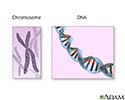Ellis-van Creveld syndrome
Chondroectodermal dysplasia; EVC
Ellis-van Creveld syndrome is a rare genetic disorder that affects bone growth.
Causes
Ellis-van Creveld is passed down through families (inherited). It is caused by defects in 1 of 2 Ellis-van Creveld syndrome genes (EVC and EVC2). These genes are positioned next to each other on the same chromosome.
The severity of the disease varies from person to person. The highest rate of the condition is seen among the Old Order Amish population of Lancaster County, Pennsylvania. It is fairly rare in the general population.
Symptoms
Symptoms may include:
- Cleft lip or palate
- Epispadias or undescended testicle (cryptorchidism)
- Extra fingers (polydactyly)
- Limited range of motion
- Nail problems, including missing or deformed nails
- Short arms and legs, especially forearm and lower leg
- Short height, between 3.5 to 5 feet (1 to 1.5 meters) tall
- Sparse, absent, or fine textured hair
- Tooth abnormalities, such as peg teeth, widely-spaced teeth
- Teeth present at birth (natal teeth)
- Delayed or missing teeth
Exams and Tests
Signs of this condition include:
- Growth hormone deficiency
- Heart defects, such as a hole in the heart (atrial septal defect), occur in about half of all cases
Tests include:
- Chest x-ray
- Echocardiogram
- Genetic testing may be performed for genetic variants in one of the two EVC genes
- Skeletal x-ray
- Ultrasound
- Urinalysis
Treatment
Treatment depends on which body system is affected and the severity of the problem. The condition itself is not treatable, but many of the complications can be treated.
Support Groups
More information and support for people with EVC and their families can be found at:
- National Foundation for Ectodermal Dysplasias (NFED) -- rarediseases.org/organizations/national-foundation-for-ectodermal-dysplasias-nfed/
- Little People of America, Inc -- rarediseases.org/non-member-patient/little-people-of-america-inc/
Outlook (Prognosis)
Many babies with this condition die in early infancy. Most often this is due to a small chest or heart defect. Stillbirth is common.
The outcome depends on which body system is involved and to what extent that body system is involved. Like many genetic conditions involving bones or the physical structure, intelligence is normal.
Possible Complications
Complications may include:
- Bone abnormalities
- Breathing difficulty
- Congenital heart disease (CHD) especially atrial septal defect (ASD)
- Kidney disease
When to Contact a Medical Professional
Contact your provider if your child has symptoms of this syndrome. If you have a family history of EVC syndrome and your child has any symptoms, visit your provider.
Genetic counseling can help families understand the condition and how to care for the person.
Prevention
Genetic counseling is recommended for prospective parents from a high-risk group, or who have a family history of EVC syndrome.
References
Chitty LS, Wilson LC, Ushakov F. Diagnosis and management of fetal skeletal abnormalities. In: Pandya PP, Oepkes D, Sebire NJ, Wapner RJ, eds. Fetal Medicine: Basic Science and Clinical Practice. 3rd ed. Philadelphia, PA: Elsevier; 2020:chap 34.
Hecht JT, Horton WA. Other inherited disorders of skeletal development. In: Kliegman RM, St. Geme JW, Blum NJ, Shah SS, Tasker RC, Wilson KM, eds. Nelson Textbook of Pediatrics. 21st ed. Philadelphia, PA: Elsevier; 2020:chap 720.
National Center for Advancing Translational Sciences. Genetic and Rare Diseases Information Center website. Ellis-van-Creveld syndrome. rarediseases.info.nih.gov/diseases/1301/ellis-van-creveld-syndrome. Updated February 2023. Accessed October 17, 2023.
Review Date: 9/18/2023



















